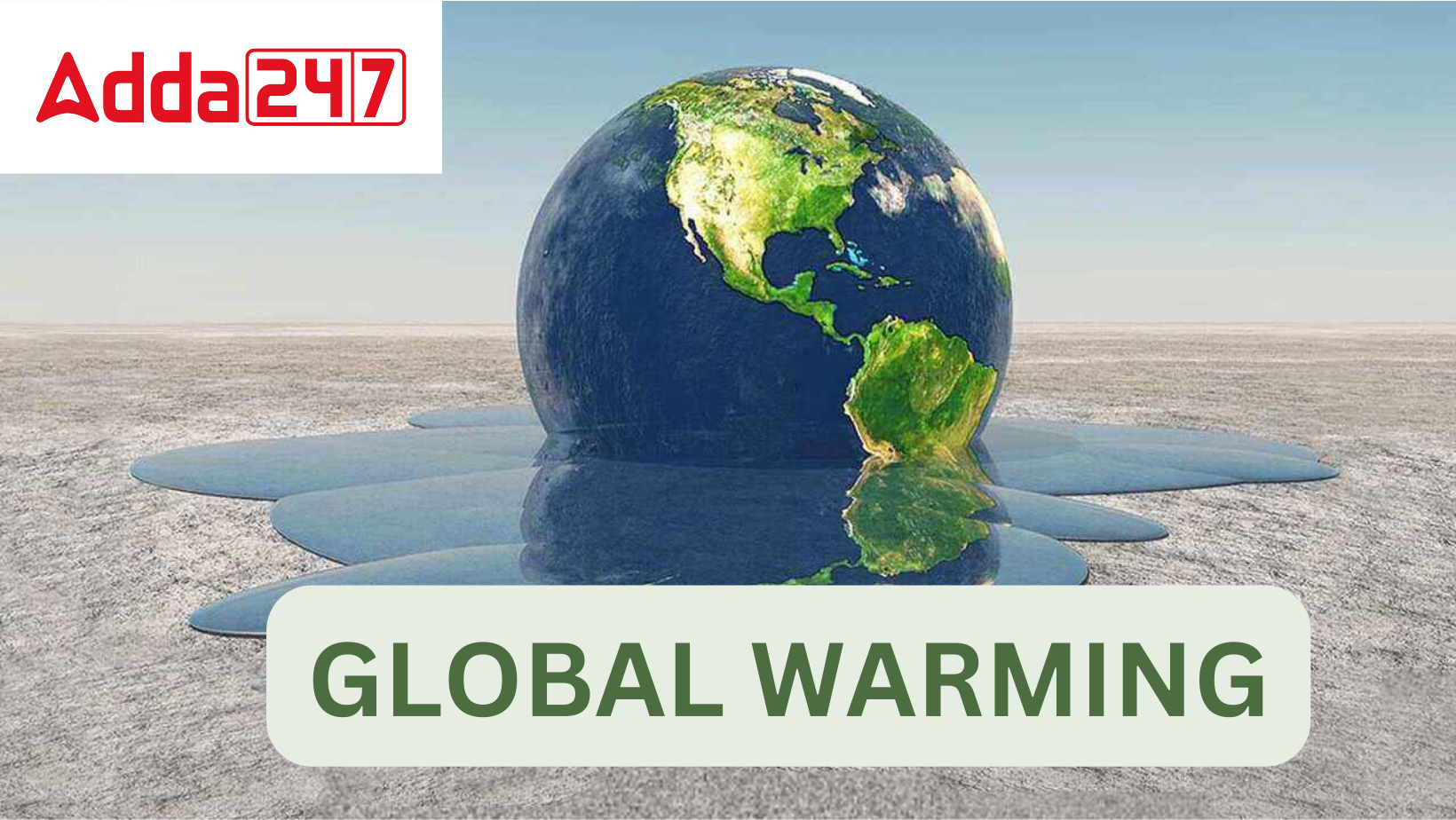Global Warming Definition
Global warming is the phenomenon of a slow rise in temperature close to the earth’s surface. Over the last century or two, this tendency has been noted. The earth’s climate pattern has been altered by this alteration. Although the idea of global warming is still up for debate, scientists have presented evidence to support the idea that the earth’s temperature is steadily increasing.
Global warming has a number of causes that are harmful to people, plants, and animals. Global warming could be a result of human activity or could be natural. Understanding the harmful effects of global warming is crucial for tackling the problems.
Read now: Global Warming Essay
Global Warming Causes
When carbon dioxide (CO2) and other air pollutants build up in the atmosphere, they absorb sunlight and solar rays that have already reflected off the surface of the earth. Normally, this radiation would escape into space, but because these pollutants may linger in the atmosphere for many years or even decades, they trap the heat and make the planet hotter. The greenhouse effect is the result of these heat-trapping pollutants, notably carbon dioxide, methane, nitrous oxide, water vapour, and synthetic fluorinated gases, which are referred to as greenhouse gases.
Man made causes of Global warming
Deforestation
The primary source of oxygen is plants. They maintain environmental balance by absorbing carbon dioxide and exhaling oxygen. For a variety of domestic and commercial uses, forests are being destroyed. This has caused an imbalance in the environment, which has resulted in global warming.
Consumption of Vehicles
Even over extremely short distances, using a car produces a variety of gaseous pollutants. When fossil fuels are burned in vehicles, a lot of carbon dioxide and other poisons are released into the atmosphere, raising the temperature.
Chlorofluorocarbon
Humans have been introducing CFCs into the environment through the excessive use of air conditioners and freezers, which has an impact on the ozone layer in the atmosphere and results in global warming. The ozone layer shields the surface of the earth from the sun’s harmful ultraviolet rays. By causing the ozone layer to thin and make way for ultraviolet rays, CFCs have raised the earth’s temperature.
Development of industries
The beginning of industrialization has resulted in a dramatic rise in the earth’s temperature which increases global warming. The earth’s temperature is rising as a result of the manufacturers’ damaging emissions.
According to a 2013 report from the Intergovernmental Panel on Climate Change, the global temperature rose by 0.9 degrees Celsius between 1880 and 2012. When compared to the pre-industrial mean temperature, the rise is 1.1 degrees Celsius.
Agriculture
Agriculture is one of the reasons for global warming as carbon dioxide and methane gas are produced during several farming processes. These raise the earth’s temperature by increasing the number of greenhouse gases in the atmosphere.
Increasing population
More individuals breathing equals more people in the population and it is one of the causes of global warming. As a result, the atmospheric concentration of carbon dioxide, the main gas responsible for global warming, rises.
Natural Causes of Global Warming
Volcanoes
One of the main natural causes of global warming is volcanoes. Volcanic eruptions release smoke and ash into the sky, which has an impact on the climate.
Water Vapour
One sort of greenhouse gas is water vapour. As the earth’s temperature rises, more water evaporation from water bodies occurs and stays in the atmosphere, contributing to global warming.
Melting Permafrost
Under the surface of the Earth, there is permafrost, which is frozen soil that has been trapped in ambient gases for a long time. It can be found in glaciers. The gases are released back into the atmosphere as the permafrost melts, raising the temperature of the planet.
Forest Blazes
Forest fires and blazes produce a lot of smoke that contains carbon. Global warming results from the release of these gases into the atmosphere, which raises the earth’s temperature.
Global Warming Effects
Following are the major effects of Global warming
Rise in Temperature
The temperature of the world has increased significantly as a result of global warming. The earth’s temperature has risen by 1 degrees since 1880. As a result, there has been an increase in glacier melting, which has raised the sea level. The consequences for coastal areas could be catastrophic.
Threats to the Ecosystem
Coral reefs have been impacted by global warming, which may result in the extinction of plants and animals. The fragility of coral reefs has gotten worse as a result of the rise in global temperatures.
Climate Change
Climate conditions have changed as a result of global warming. There are both droughts and floods in some regions. The cause of this climatic mismatch is global warming.
Spread of Diseases
Heat and humidity patterns change as a result of global warming. This has caused the movement of disease-carrying mosquitoes.
High Mortality Rates
The average death toll typically rises due to an increase in floods, tsunamis, and other natural calamities. Additionally, such occurrences may lead to the spread of diseases that may endanger human life.
Loss of Natural Habitat
Numerous plants and animals lose their habitats as a result of worldwide climate change. The creatures in this situation are forced to leave their native habitat, and many of them even go extinct. This is yet another significant effect of climate change on biodiversity.
What is the Greenhouse effect?
A glass structure called a greenhouse is a building where plants can be grown. The air in the greenhouse and the plants are heated by the sun’s rays. The greenhouse is heated by the internal heat that cannot escape, which is necessary for the plant’s growth. The earth’s atmosphere is the same way.
The sun warms the earth’s atmosphere throughout the day. The ground cools at night, and heat is radiated back into the atmosphere. The earth’s atmosphere’s greenhouse gases absorb the heat throughout this process. This is what warms the earth’s surface and makes it possible for life to exist on the planet.
Must read: Greenhouse Gases
To Know Global warming and Greenhouse, watch this video
Global Warming- Definition, Causes and Effects in Hindi
ग्लोबल वार्मिंग पृथ्वी की सतह के करीब तापमान में धीमी वृद्धि की घटना है। पिछली एक या दो शताब्दियों में, इस प्रवृत्ति पर ध्यान दिया गया है। इस परिवर्तन से पृथ्वी के जलवायु पैटर्न में बदलाव आया है। हालांकि ग्लोबल वार्मिंग का विचार अभी भी बहस का विषय है, वैज्ञानिकों ने इस विचार का समर्थन करने के लिए साक्ष्य प्रस्तुत किया है कि पृथ्वी का तापमान लगातार बढ़ रहा है।
ग्लोबल वार्मिंग के कई कारण हैं जो लोगों, पौधों और जानवरों के लिए हानिकारक हैं। ग्लोबल वार्मिंग मानव गतिविधि का परिणाम हो सकता है या प्राकृतिक हो सकता है। समस्याओं से निपटने के लिए ग्लोबल वार्मिंग के हानिकारक प्रभावों को समझना महत्वपूर्ण है।
ग्लोबल वार्मिंग के कारण
जब कार्बन डाइऑक्साइड (CO2) और अन्य वायु प्रदूषक वातावरण में बनते हैं, तो वे सूर्य के प्रकाश और सौर किरणों को अवशोषित करते हैं जो पहले ही पृथ्वी की सतह से परावर्तित हो चुकी होती हैं। आम तौर पर, यह विकिरण अंतरिक्ष में भाग जाता है, लेकिन क्योंकि ये प्रदूषक कई वर्षों या दशकों तक वातावरण में रह सकते हैं, वे गर्मी को रोक लेते हैं और ग्रह को गर्म बना देते हैं। ग्रीनहाउस प्रभाव इन गर्मी-फँसाने वाले प्रदूषकों, विशेष रूप से कार्बन डाइऑक्साइड, मीथेन, नाइट्रस ऑक्साइड, जल वाष्प और सिंथेटिक फ्लोरिनेटेड गैसों का परिणाम है, जिन्हें ग्रीनहाउस गैसों के रूप में संदर्भित किया जाता है।
ग्लोबल वार्मिंग के मानव निर्मित कारण
वनों की कटाई
ऑक्सीजन का प्राथमिक स्रोत पौधे हैं। वे कार्बन डाइऑक्साइड को अवशोषित करके और ऑक्सीजन को बाहर निकालकर पर्यावरण संतुलन बनाए रखते हैं। विभिन्न प्रकार के घरेलू और व्यावसायिक उपयोगों के लिए जंगलों को नष्ट किया जा रहा है। इससे पर्यावरण में असंतुलन पैदा हो गया है, जिसके परिणामस्वरूप ग्लोबल वार्मिंग हुई है।
वाहनों की खपत
बहुत कम दूरी पर भी, कार का उपयोग करने से विभिन्न प्रकार के गैसीय प्रदूषक पैदा होते हैं। जब वाहनों में जीवाश्म ईंधन जलाया जाता है, तो बहुत सारी कार्बन डाइऑक्साइड और अन्य जहर वातावरण में छोड़े जाते हैं, जिससे तापमान बढ़ जाता है।
क्लोरोफ्लोरोकार्बन
मनुष्य एयर कंडीशनर और फ्रीजर के अत्यधिक उपयोग के माध्यम से सीएफसी को पर्यावरण में पेश कर रहा है, जिसका वातावरण में ओजोन परत पर प्रभाव पड़ता है और ग्लोबल वार्मिंग का परिणाम होता है। ओजोन परत पृथ्वी की सतह को सूर्य की हानिकारक पराबैंगनी किरणों से बचाती है। ओजोन परत को पतला करके और पराबैंगनी किरणों के लिए रास्ता बनाकर, सीएफसी ने पृथ्वी का तापमान बढ़ा दिया है।
उद्योगों का विकास
औद्योगीकरण की शुरुआत के परिणामस्वरूप पृथ्वी के तापमान में नाटकीय वृद्धि हुई है जो ग्लोबल वार्मिंग को बढ़ाती है। निर्माताओं के हानिकारक उत्सर्जन के परिणामस्वरूप पृथ्वी का तापमान बढ़ रहा है।
जलवायु परिवर्तन पर अंतर सरकारी पैनल की 2013 की एक रिपोर्ट के अनुसार, 1880 और 2012 के बीच वैश्विक तापमान में 0.9 डिग्री सेल्सियस की वृद्धि हुई। पूर्व-औद्योगिक औसत तापमान की तुलना में, वृद्धि 1.1 डिग्री सेल्सियस है।
कृषि
कृषि ग्लोबल वार्मिंग के कारणों में से एक है क्योंकि कई कृषि प्रक्रियाओं के दौरान कार्बन डाइऑक्साइड और मीथेन गैस का उत्पादन होता है। ये वातावरण में ग्रीनहाउस गैसों की संख्या बढ़ाकर पृथ्वी के तापमान को बढ़ाते हैं।
बढ़ती आबादी
अधिक व्यक्ति सांस लेते हैं, जनसंख्या में अधिक लोग बराबर होते हैं और यह ग्लोबल वार्मिंग के कारणों में से एक है। नतीजतन, ग्लोबल वार्मिंग के लिए जिम्मेदार मुख्य गैस कार्बन डाइऑक्साइड की वायुमंडलीय सांद्रता बढ़ जाती है।
ग्लोबल वार्मिंग के प्राकृतिक कारण
ज्वालामुखी
ग्लोबल वार्मिंग के मुख्य प्राकृतिक कारणों में से एक ज्वालामुखी है। ज्वालामुखी विस्फोट से आसमान में धुंआ और राख निकलता है, जिसका प्रभाव जलवायु पर पड़ता है।
जल वाष्प
जल वाष्प एक प्रकार की ग्रीनहाउस गैस है। जैसे-जैसे पृथ्वी का तापमान बढ़ता है, जल निकायों से अधिक पानी का वाष्पीकरण होता है और वातावरण में रहता है, जिससे ग्लोबल वार्मिंग में योगदान होता है।
पिघलता हुआ पर्माफ्रॉस्ट
पृथ्वी की सतह के नीचे पर्माफ्रॉस्ट है, जो जमी हुई मिट्टी है जो लंबे समय तक परिवेशी गैसों में फंसी रही है। यह ग्लेशियरों में पाया जा सकता है। जैसे ही पर्माफ्रॉस्ट पिघलता है, गैसें वापस वायुमंडल में छोड़ दी जाती हैं, जिससे ग्रह का तापमान बढ़ जाता है।
जंगल की लपटें
जंगल की आग और धधकने से बहुत अधिक धुंआ निकलता है जिसमें कार्बन होता है। इन गैसों के वायुमंडल में छोड़े जाने से ग्लोबल वार्मिंग का परिणाम होता है, जिससे पृथ्वी का तापमान बढ़ जाता है।
ग्लोबल वार्मिंग प्रभाव
ग्लोबल वार्मिंग के प्रमुख प्रभाव निम्नलिखित हैं
तापमान में वृद्धि
ग्लोबल वार्मिंग के कारण दुनिया का तापमान काफी बढ़ गया है। 1880 के बाद से पृथ्वी के तापमान में 1 डिग्री की वृद्धि हुई है। इसके परिणामस्वरूप ग्लेशियर पिघलने में वृद्धि हुई है, जिससे समुद्र का स्तर बढ़ा है। तटीय क्षेत्रों के लिए परिणाम भयावह हो सकते हैं।
पारिस्थितिकी तंत्र के लिए खतरा
ग्लोबल वार्मिंग से प्रवाल भित्तियाँ प्रभावित हुई हैं, जिसके परिणामस्वरूप पौधों और जानवरों का विलुप्त होना हो सकता है। वैश्विक तापमान में वृद्धि के परिणामस्वरूप प्रवाल भित्तियों की नाजुकता और भी बदतर हो गई है।
जलवायु परिवर्तन
ग्लोबल वार्मिंग के परिणामस्वरूप जलवायु की स्थिति बदल गई है। कुछ क्षेत्रों में सूखा और बाढ़ दोनों हैं। इस जलवायु बेमेल का कारण ग्लोबल वार्मिंग है।
ग्लोबल वार्मिंग के परिणामस्वरूप गर्मी और आर्द्रता पैटर्न बदलते हैं। इससे रोग फैलाने वाले मच्छरों की आवाजाही हुई है।
उच्च मृत्यु दर
बाढ़, सूनामी और अन्य प्राकृतिक आपदाओं में वृद्धि के कारण औसत मृत्यु दर आमतौर पर बढ़ जाती है। इसके अतिरिक्त, ऐसी घटनाओं से ऐसी बीमारियाँ फैल सकती हैं जो मानव जीवन को खतरे में डाल सकती हैं।
प्राकृतिक आवास का नुकसान
दुनिया भर में जलवायु परिवर्तन के परिणामस्वरूप असंख्य पौधे और जानवर अपने आवास खो रहे हैं। इस स्थिति में जीव अपने मूल निवास स्थान को छोड़ने के लिए मजबूर हो जाते हैं, और उनमें से कई विलुप्त भी हो जाते हैं। यह जैव विविधता पर जलवायु परिवर्तन का एक और महत्वपूर्ण प्रभाव है।
ग्रीनहाउस प्रभाव क्या है?
एक कांच की संरचना जिसे ग्रीनहाउस कहा जाता है वह एक ऐसी इमारत है जहां पौधों को उगाया जा सकता है। ग्रीनहाउस में हवा और पौधे सूर्य की किरणों से गर्म होते हैं। ग्रीनहाउस आंतरिक गर्मी से गर्म होता है जो बच नहीं सकता, जो पौधे के विकास के लिए आवश्यक है। पृथ्वी का वातावरण भी ऐसा ही है।
सूर्य पूरे दिन पृथ्वी के वातावरण को गर्म रखता है। जमीन रात में ठंडी हो जाती है, और गर्मी वापस वातावरण में विकीर्ण हो जाती है। इस प्रक्रिया के दौरान पृथ्वी के वायुमंडल की ग्रीनहाउस गैसें ऊष्मा को अवशोषित करती हैं। यह वह है जो पृथ्वी की सतह को गर्म करता है और ग्रह पर जीवन का अस्तित्व संभव बनाता है।
Global Warming FAQs
Que. What is Global Warming?
Ans. Global warming is the phenomenon of a slow rise in temperature close to the earth’s surface.
Que. What are the 5 effects of global warming?
Ans. Some common effects of global warming are an increase in temperature, a threat to the ecosystem, a high mortality rate, loss of natural habitat and spreading of disease.
Que. Why is global warming a problem?
Ans. Global warming can result in many serious alterations to the environment, eventually impacting human health.
Que. How do we prevent global warming?
Ans. To prevent global warming drive less, recycle more, plant more and more trees etc.
Que. How does climate affect our life?
Ans. As ocean temperatures rise, hurricanes are getting stronger and wetter, which can cause direct and indirect deaths.









 CBSE Date Sheet 2026 for Class 10 & ...
CBSE Date Sheet 2026 for Class 10 & ...
 CBSE Class 10 Date Sheet 2026, Check 10t...
CBSE Class 10 Date Sheet 2026, Check 10t...
 CUET History Syllabus 2026 (Updated), Do...
CUET History Syllabus 2026 (Updated), Do...






